The Barri Gòtic (Catalan for “Gothic Quarter”) is the center of the old city of Barcelona. It is a part of the Ciutat Vella district.
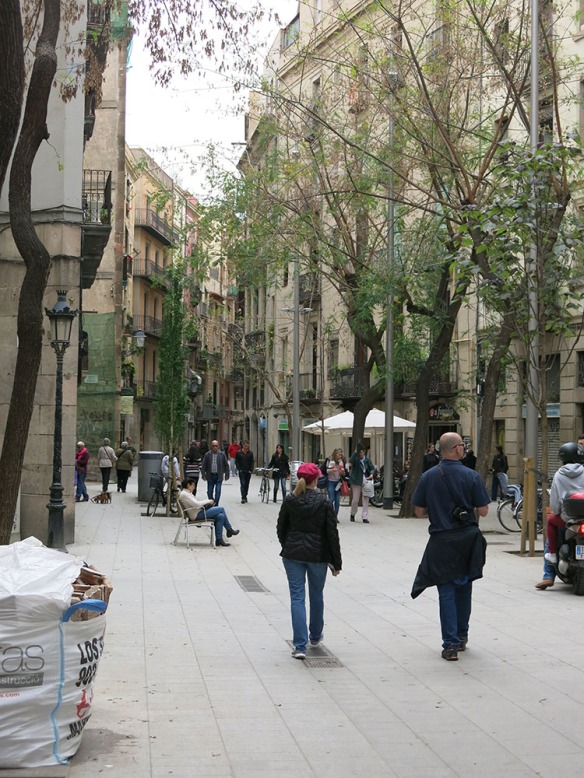
Despite several changes undergone in the 19th and early 20th century, many of the buildings date from Medieval times, some from as far back as the Roman settlement of Barcelona. Remains of the squared Roman Wall can be seen in a variety of locations.
The Barri Gòtic retains a labyrinthine street plan, with many small streets
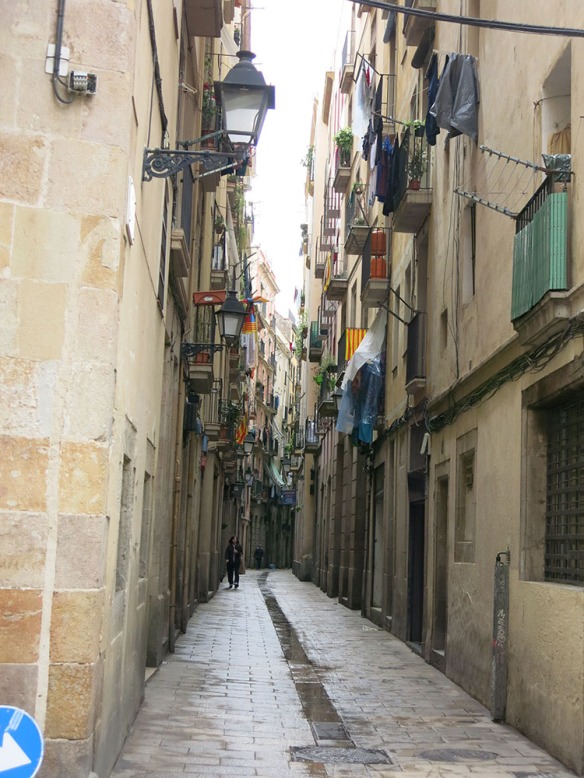
opening out into squares.
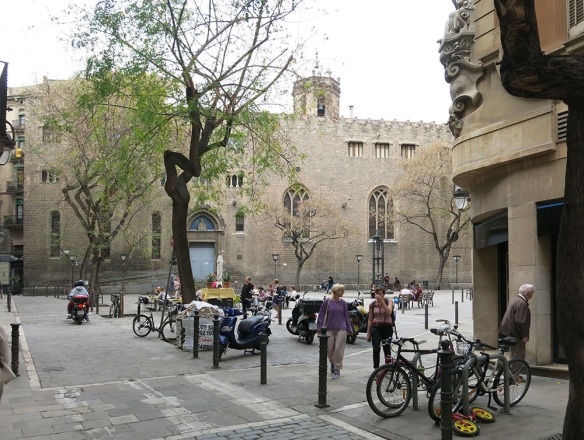
Most of the quarter is closed to regular traffic although open to service vehicles and taxis which makes it a genuine pleasure to be on foot. We had wandered through the district before and enjoyed the sensation of being a bit lost; but since we were last here the city has added some guidance to help with that.

Barcelona, like many cities including Seattle, is experiencing a building boom; and some of that extends into the Barri Gòtic. As an architect I tried to imagine the process of managing a construction project in such confined conditions. Here’s a case where a building has been demolished so a new one can take its place – but in the meantime a weather-proof insulating material had to be sprayed on the neighbor’s party wall.
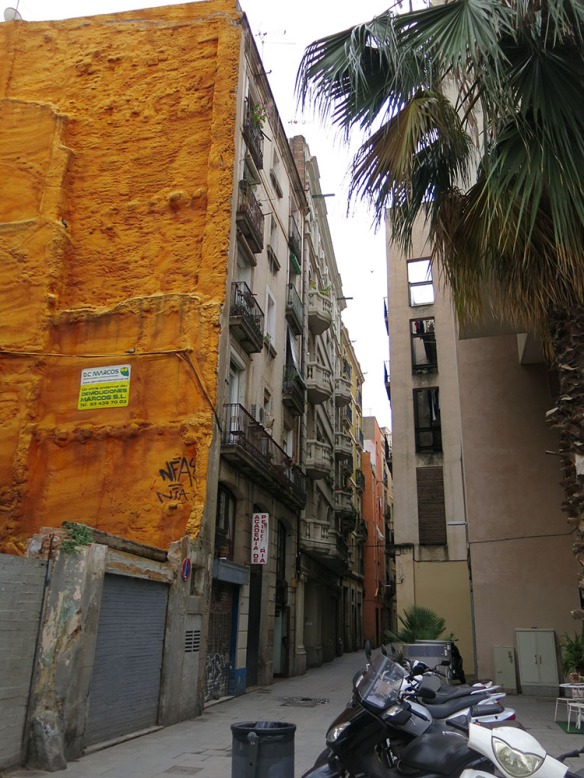
And in these tight quarters, getting rid of the demolished materials requires a ‘softer’ solution than the steel dumpsters we’re used to at home.
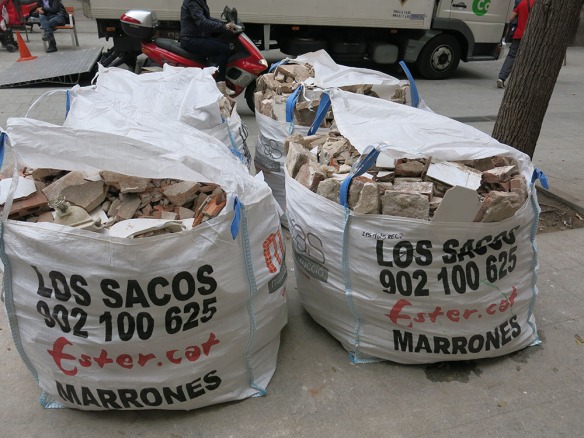
One of the pleasurable parts of walking the district is the amount of variety offered by what I like to call the ‘spaces between’. Sometimes they’re so small and filled with laundry that you wonder that any light gets in at all.

Sometimes the spaces widen for no apparent reason and become a landmark in your mind
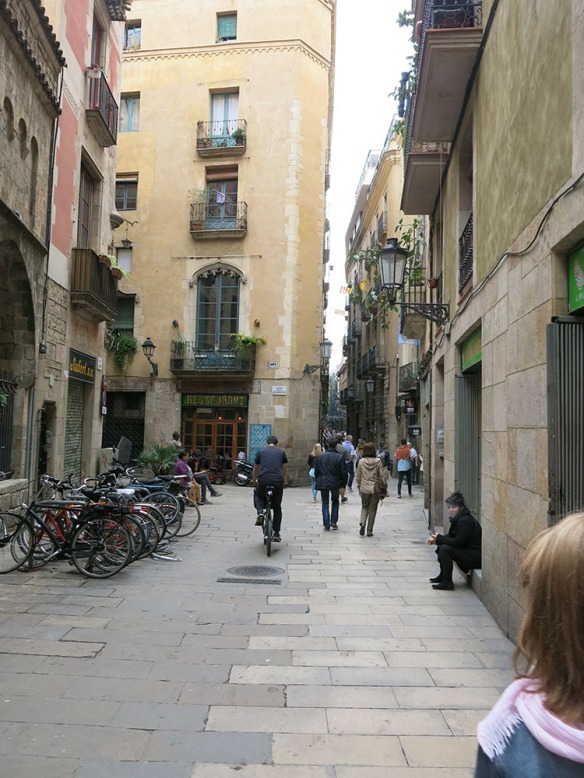
In other cases a slightly more formal architectural treatment anchors the space, even though the nature of the housing hasn’t changed substantially.
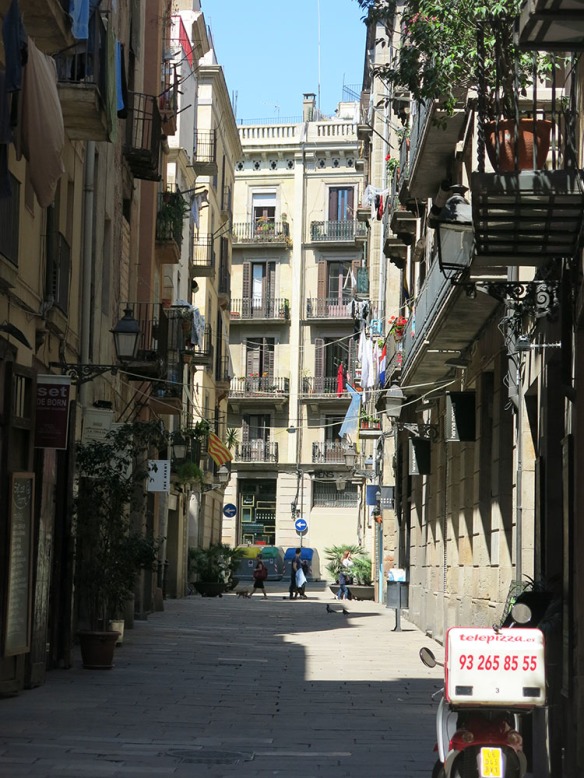
In a few places – but not too many – landscaping changes the mood entirely.
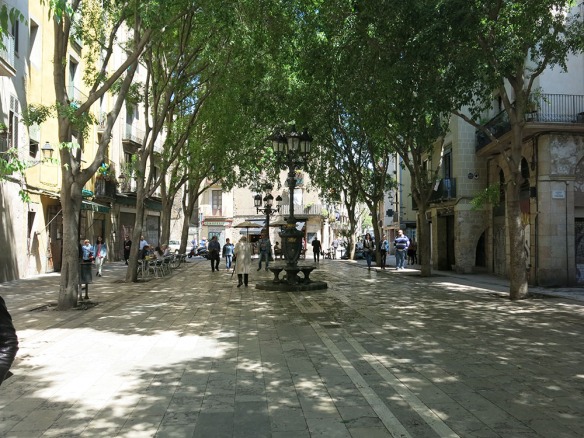
In others, a contemporary and asymetrical composition changes both your perception of the housing and your experience of moving through it.
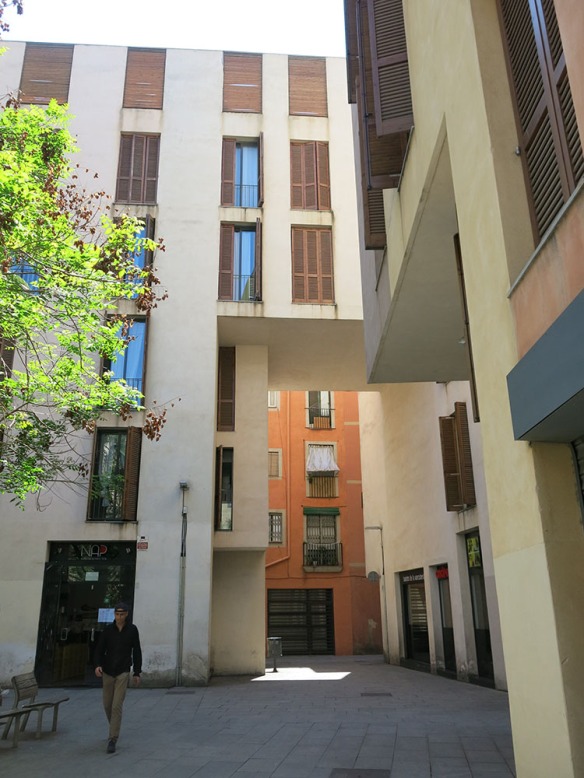
Here and there a changes of activities, such as this playground, introduces a whole new set of interactions.
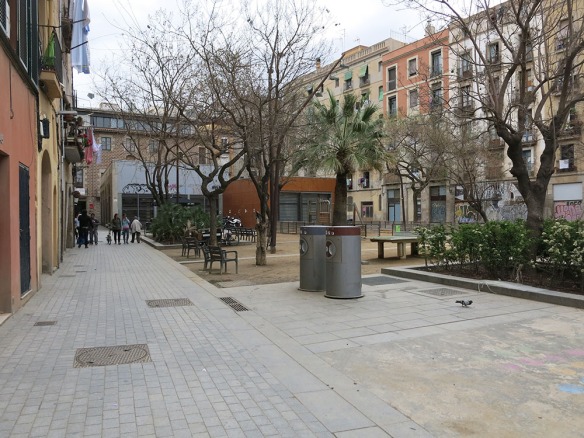
And then a surprise shows up, in this case, in a retail plaza, a bicycle-powered knife sharpener plies his 19th century trade here in the 21st.
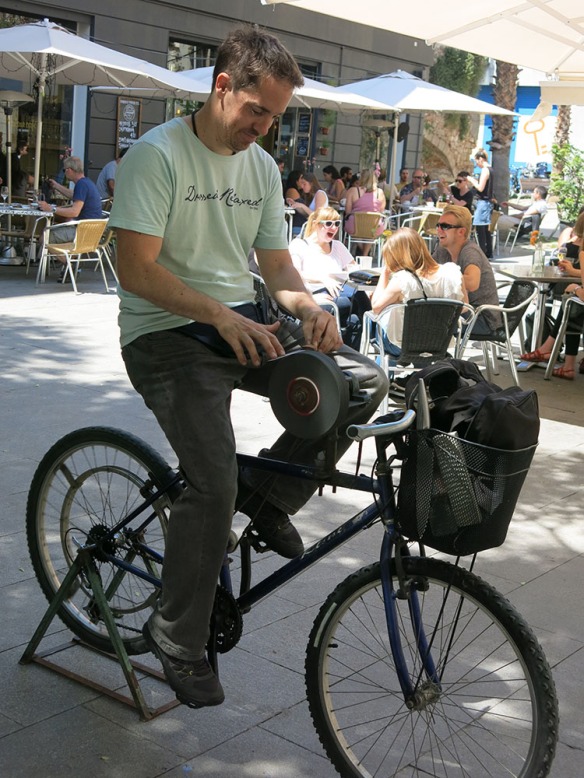
As we got closer to the Cathedral and City Hall, the street network lead us to the Santa Caterina Mercado (market). Located in La Ribera, the Mercado de Santa Caterina has been in operation since 1848. It’s one of 39 markets located in separate neighborhoods around the city. Our walk brought us to the rear entrance, adjacent to some new housing.
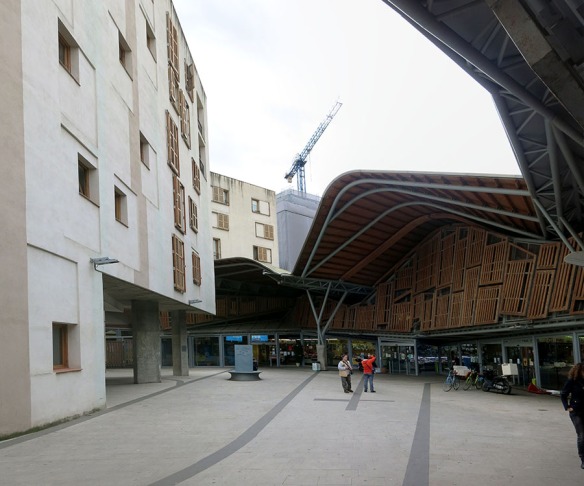
The big tile-covered roof adds a big dynamic shift to the medieval character of the old city.
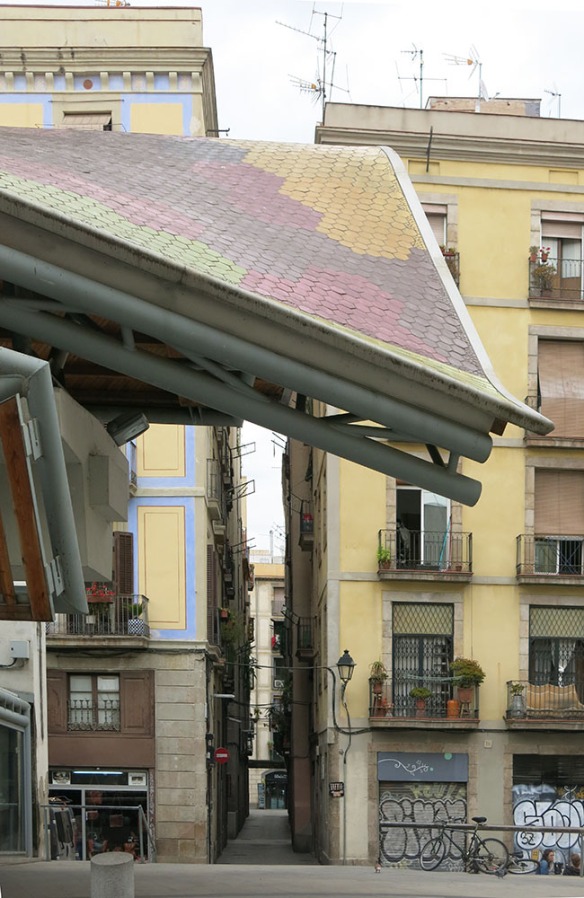
Inside, the swooping forms certainly gave this market a different flavor than the others we had seen elsewhere in the city, though the presentation of the food itself was not unusual. I suspect that the average shopper paid only a little attention to the roof.
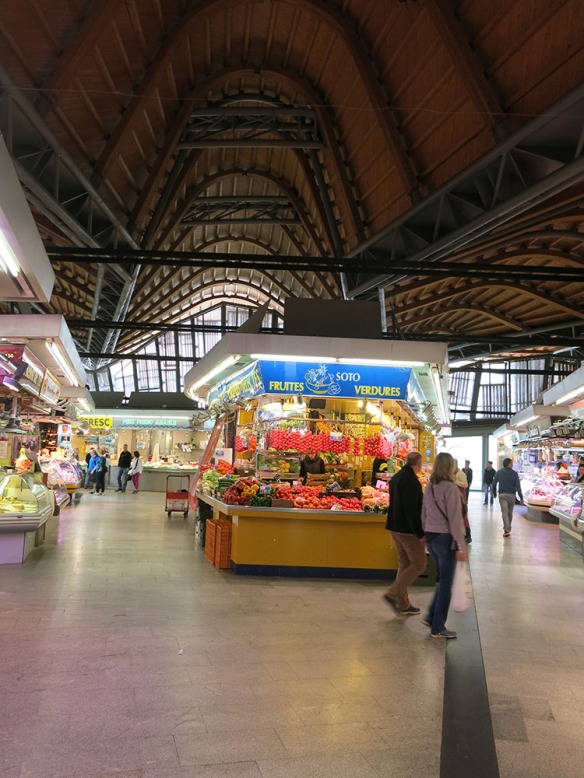
The front of the market, facing on to a long plaza leading to the Cathedral, tells the story. In a flamboyant Catalan gesture, the architects Enric Miralles and Benedetta Tagliabue, draped this colorful tile wave roof over an historic building facade.
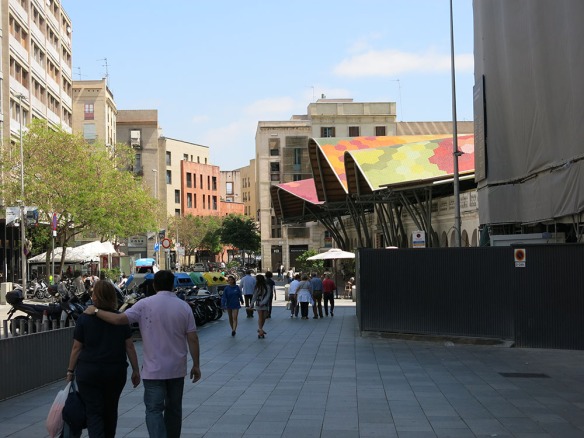
With a freedom that we found in many parts of Barcelona, they combined old and new in a way that makes you appreciate and helps you enjoy the character of each.
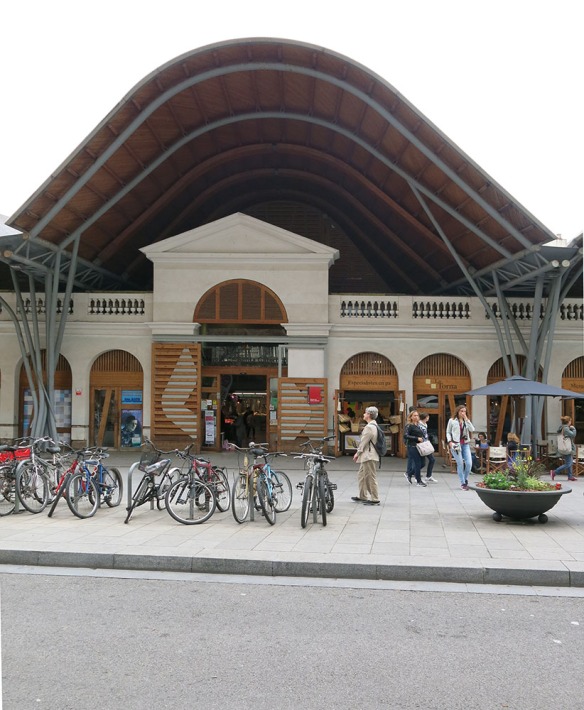
The plaza leading from the market to the Cathedral (and then the City Hall) was yet another of the modern pedestrian spaces in an historic setting that also dealt with the issue of where to put the cars. It’s an interesting lesson in design choices. The ramp to the parking is obvious in the photo below because I’ve chosen an obvious viewpoint.
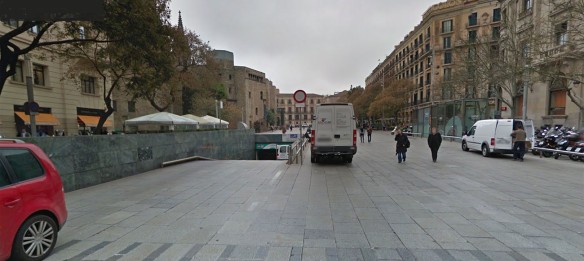
But when you’re there, the treatment is so self-effacing, and the use of materials so consistent with the people environment that you don’t give it a lot of attention. The one-story glass structure on the right holds stairs and escalators. It’s also contemporary but not in-your-face; so you tend to take it in as street furniture. And the major part of the plaza, where events are held, sits beyond both of these elements so that they really don’t come into play. Here’s a group performing a traditional Catalan dance that they do here on Sundays for themselves and to show off a well-known element of Catalan life.
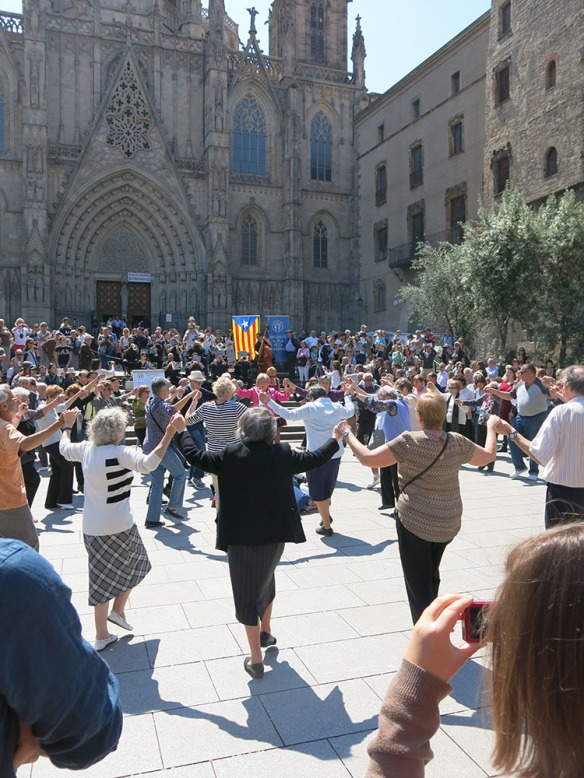
It’s a circle dance (or circles in circles) called a Sardana, with a very simple basic step and a few subtle variations, accompanied by a small orchestra, a cobla, a band consisting of 10 wind instruments, double bass and a tambori (drum). Originally a 16th century peasant dance, it became associated with the Catalan independence movement and now acts as a symbol of Catalan life.
The cathedral in the background is a bit misleading, in that in the late 19th century, a neo-Gothic façade was constructed over the nondescript exterior that was common to Catalan churches. Inside, the character is simpler.
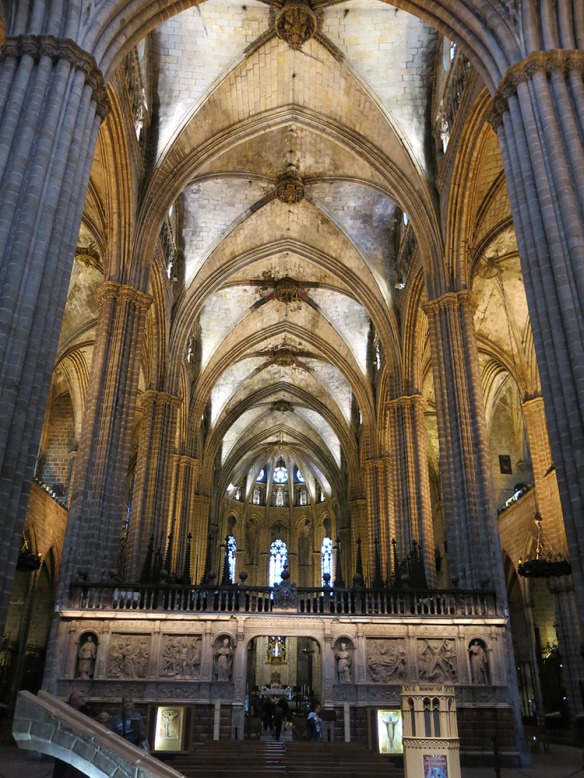
The Cathedral of the Holy Cross and Saint Eulalia , also known as Barcelona Cathedral, is the Gothic cathedral and seat of the Archbishop of Barcelona, Spain. The cathedral was constructed from the 13th to 15th centuries, with the principal work done in the 14th century.
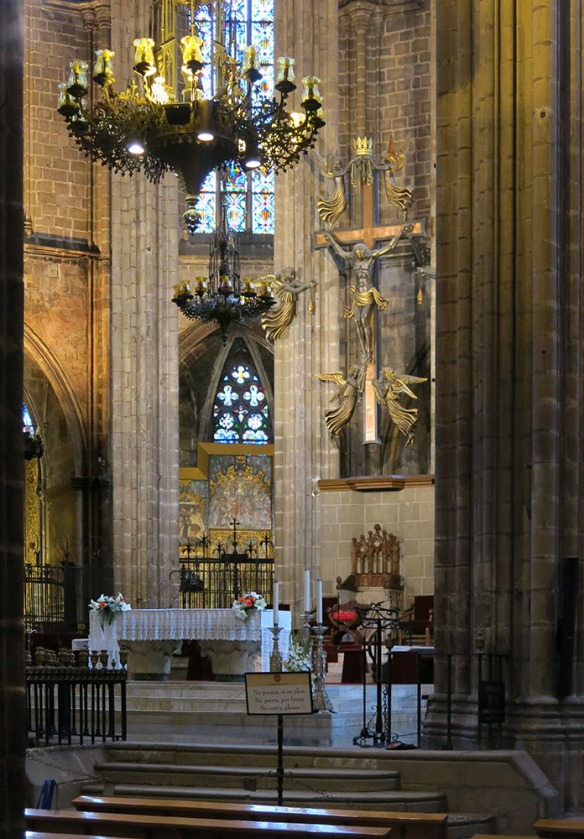
There are plenty of rich and well-crafted materials; but not the over-the-top use of gold that we saw in Toledo. It may have something to do with Catalan restraint.
The cloister was completed in 1448.
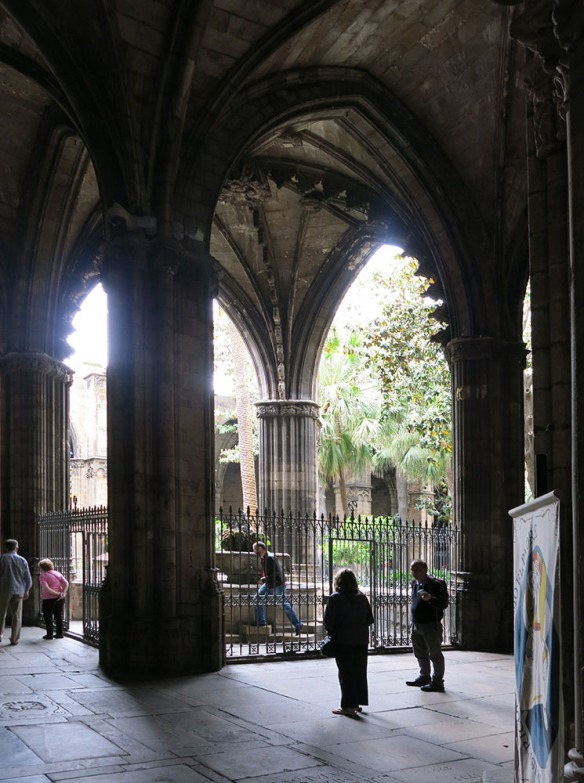
Some parts of the floor serve as burial sites with simple strong symbols carved into the surface of the stone covers.

The cloister also encloses the Well of the Geese (Font de les Oques)
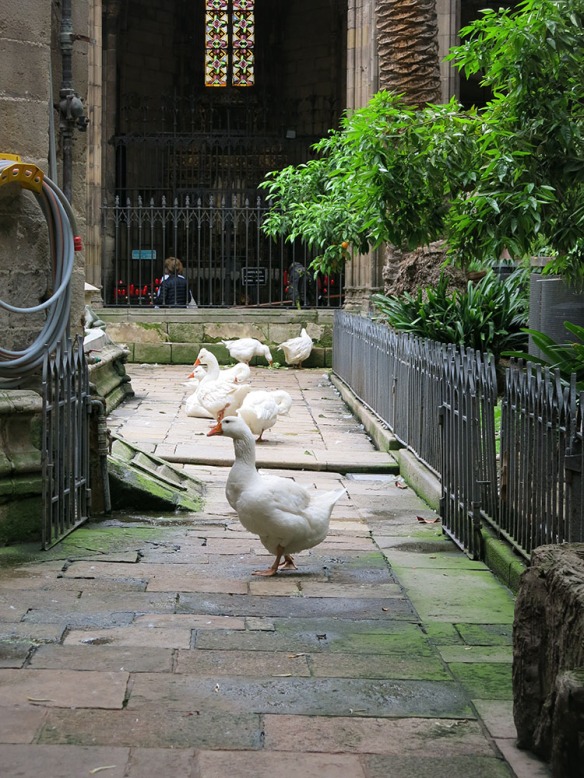
The geese are associated with some religious event in the cathedral’s past and get their own pool and fountain and run of the cloister as a result.
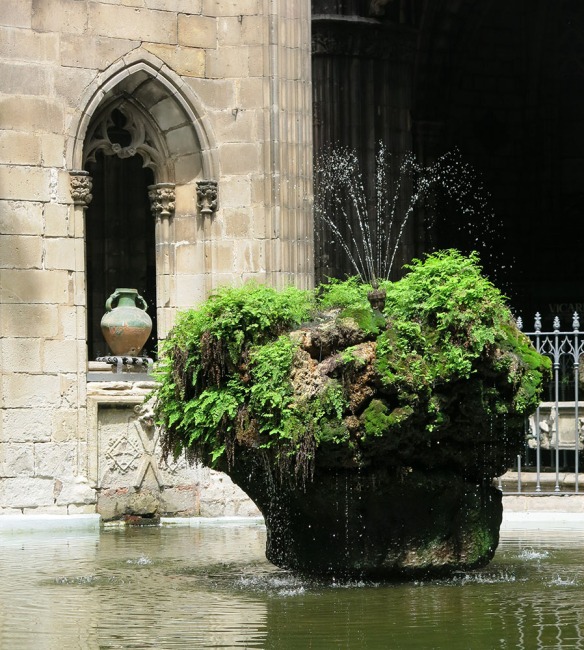
I always forget, until pleasantly reminded, that we’re in the Mediterranean, where tropical plants such as palm trees grow comfortably.
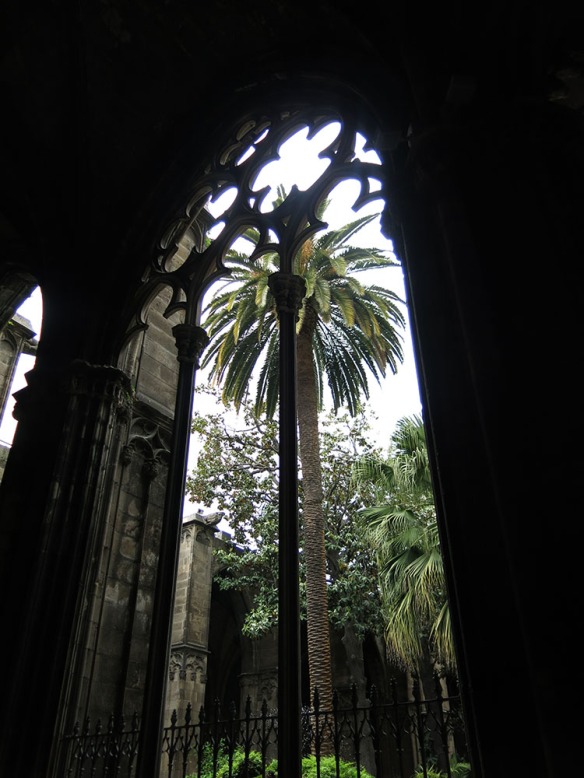
The roof is notable for its gargoyles, featuring a wide range of animals, both domestic and mythical. I didn’t have scaffolding available to be able to seem them, unfortunately; but I did get to enjoy some of the vistas from the roof walkway. This one stretches from Barcelonetta on the left to Montjuic on the right, both places we visited during our stay.

The ever-under-construction Sagrada Familia by Gaudi could also be seen.
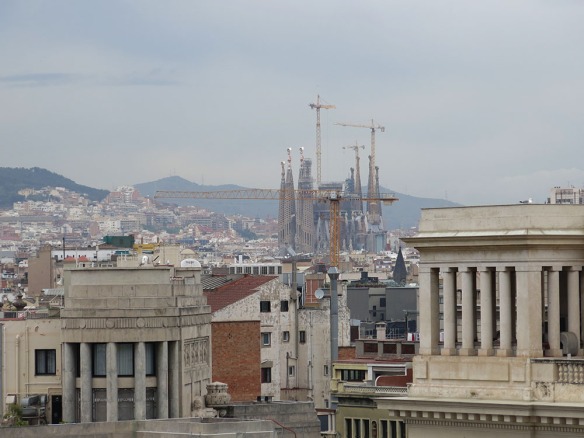
I’ll give that its own blogpost later.
Down from the cathedral we made our way to the edge of the Barri Gòtic where the street grid opens up again
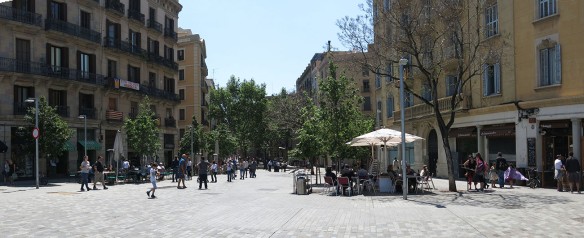
and brings the Mercat del Born into view.
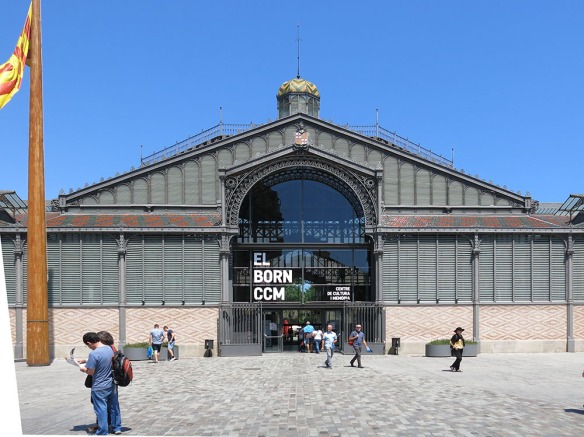
Mercat del Born is a former public market and one of the most important buildings in Barcelona, Catalonia, Spain constructed with iron. Located in the lower and eastern side of the la Ribera neighborhood, it is the largest covered square in all of Europe and marked the start of Modernisme in Catalan architecture.
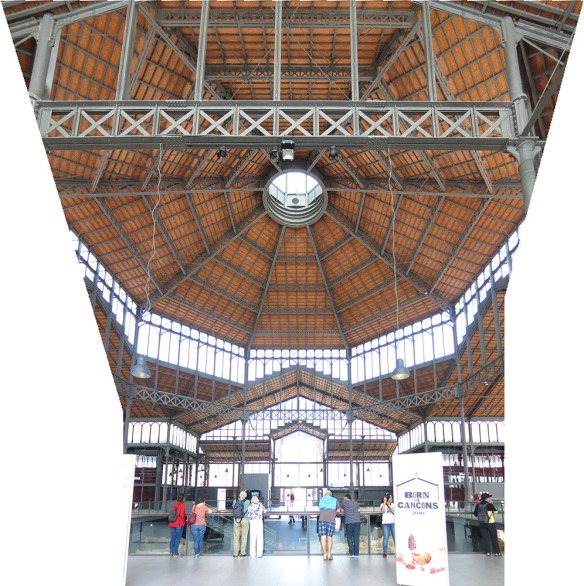
The market was designed in 1873 by the municipal architect Antoni Rovira i Trias (who also designed the Mercat de Sant Antoni) and built between 1874 and 1878 by master builder Josep Fontserè i Mestre and engineer Josep Maria Cornet i Mas. The structure of cast iron columns and metallic horses was fabricated by La Maquinista Terrestre i Marítima. The market came into operation in 1878 and was in use as the central market in town until 1971. At that point it fell into disuse for a number of years as its functions were replaced by smaller markets closer to the neighborhoods they served. Eventually, the city decided to convert the structure to a library; but in doing some exploratory excavations, came upon extensive ruins of the medieval city. It was then decided to preserve the ruins and move the library project to another location.
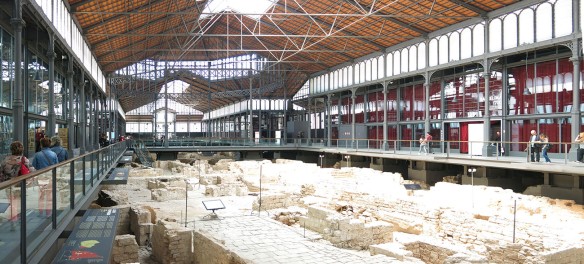
Currently, the market covers these archaeological ruins which were part of the la Ribera district that was demolished in the early eighteenth century after the defeat of Catalonia in the War of Succession in 1714. This portion of la Ribera was forcibly demolished to make way for the construction of the Ciutadella military structure as ordered by the new Spanish king, Philip V. The plan that finally came to fruition in 2013 was to expose the subterranean ruins for visitors, showing in effect, the foundations of the vibrant Catalan culture that had grown up there, illustrated here.
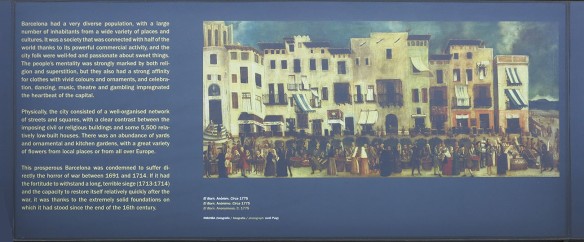
The plan would also preserve space around the museum for mixed use, cultural activities.
The market/museum makes use of very contemporary techniques for explaining the partially excavated historic city. Some of this is handsome printed material that shows the previous use (upper left), design of the building (upper right), relation to the old fort (lower right, red), and an illustration of a housing plan (lower left) that can be seen there, including individual stones in walls and pavings as recorded by archeologists.

Other techniques bring us into the digital age where video, scripted and/or in real time, can be used to clarify what the viewer is seeing.
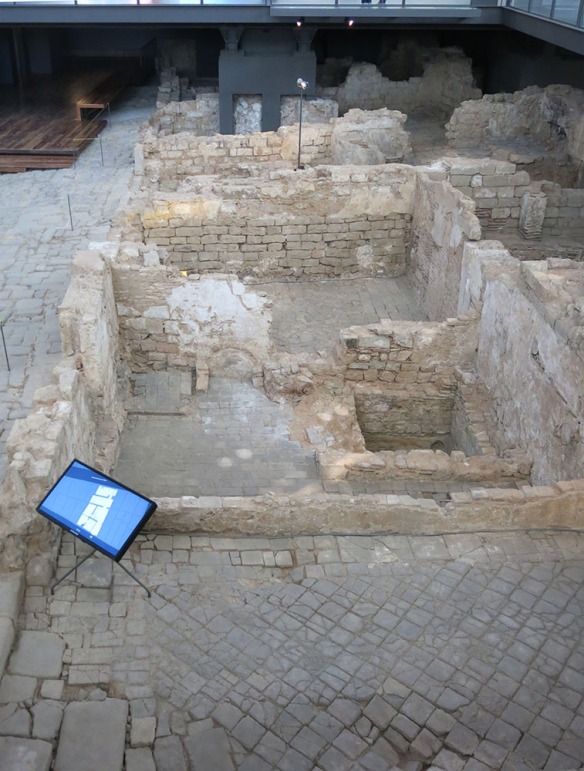
In a couple of places they found that major waterways flowed through the area.
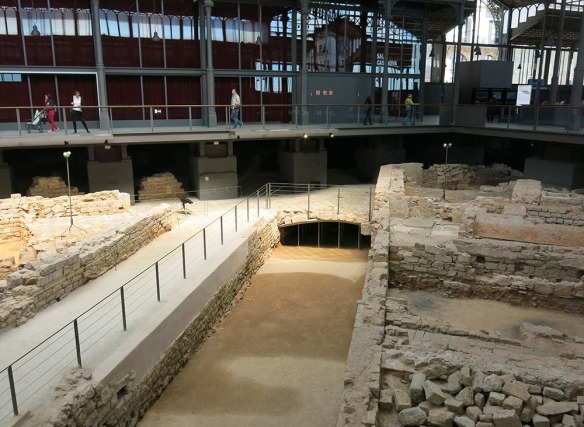
Some of the exhibits take the form of artwork to convey a more humanist flavor.

And then if all of this information wears you down, good museums handle that by providing a convenient and inviting space to take a break.
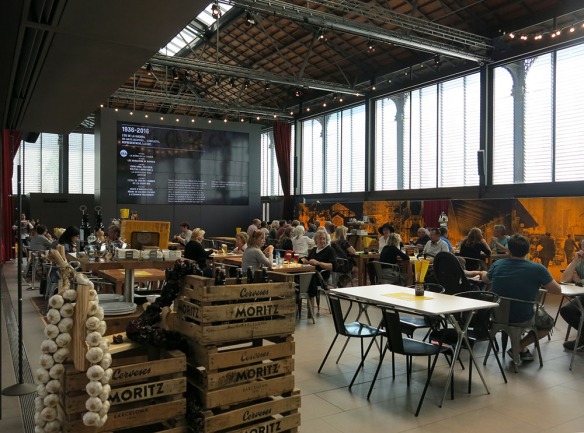
Finally, it is now possible for pedestrians to pass freely from Passeig del Born through to the other side that leads to the park of Ciutadella, so that the building becomes a conduit rather than an obstruction in the cityscape.
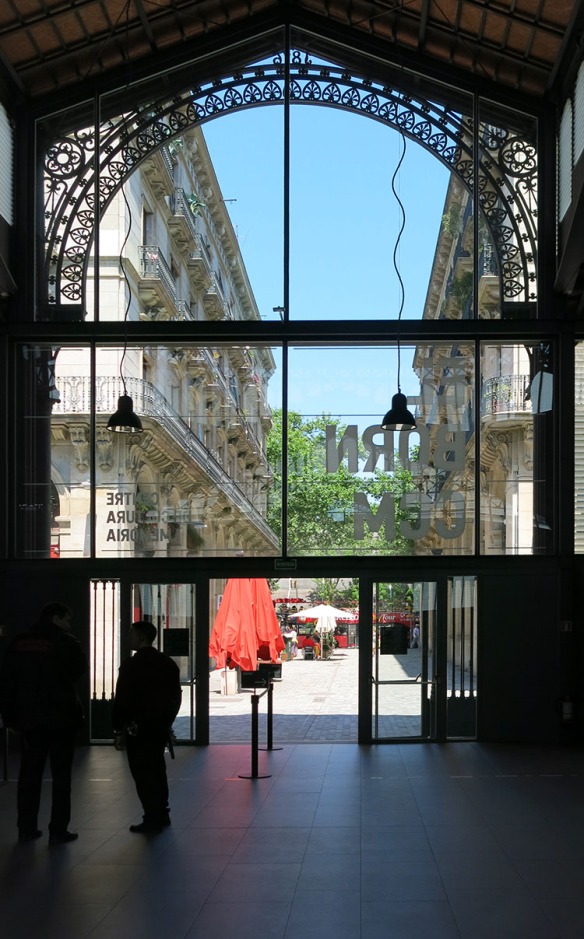
Finally, since we’ve looked at a couple of markets, I’ll include one more, La Concepcion.
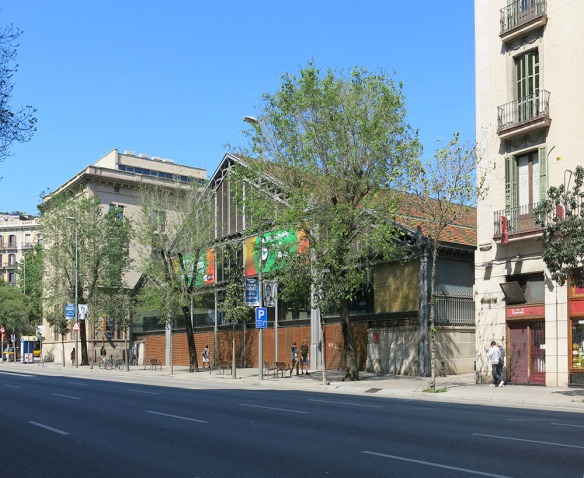
This market is outside the Barri Gòtic, in the beginning of the Eixample or expansion area of the city that took place in the late 19th century to provide for the city’s then exploding growth. The Eixample is characterized by long straight streets, a strict grid pattern crossed by wide avenues, and square blocks with chamfered corners (named illes in Catalan, manzanas in Spanish). This was a visionary, pioneering design by Ildefons Cerdà, who considered traffic and transport along with sunlight and ventilation in coming up with his characteristic octagonal blocks, where the streets broaden at every intersection making for greater visibility, better ventilation and (today) some short-stay parking space. Along with this street planning approach, a public market was located in each major neighborhood, a system that continues today in 39 individual markets around the city. La Concepcion Market was a few blocks from our hotel on our first visit to Barcelona.
The market runs the full depth of the block; and we were initially drawn in by the displays at the floral end on the street opposite to the one above.
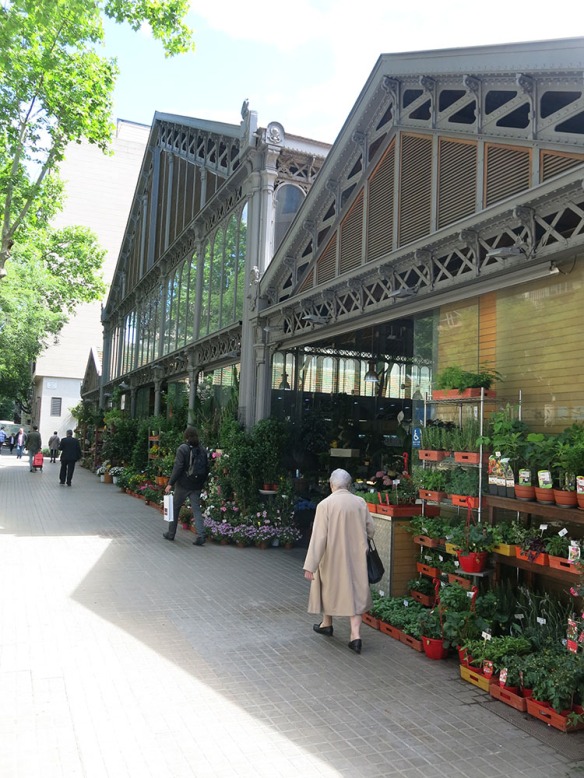
These invite you to explore further
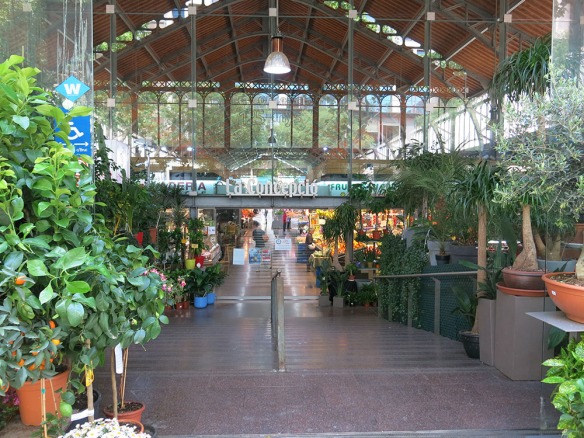
As you can see the structure has been crafted of steel frames that were in vogue in the late 19th century and part of the ‘modernista’ architectural movement at the time. The goods offered for sale are what you would expect at any good farmers’ market.
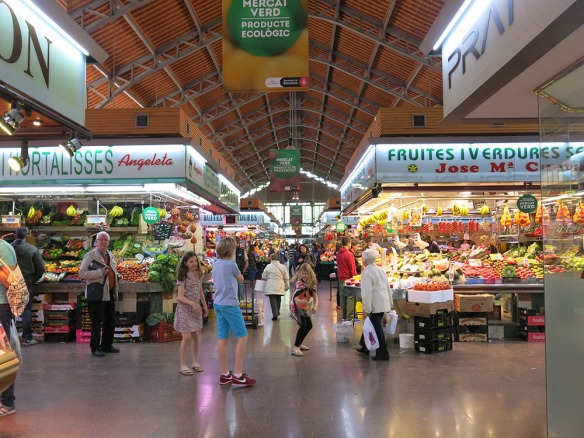
And as you can see, they are actively engaged with current ‘green’ and organic movement. At the other end we were surprised. Here, next to the ramp leading to the fresh foods,
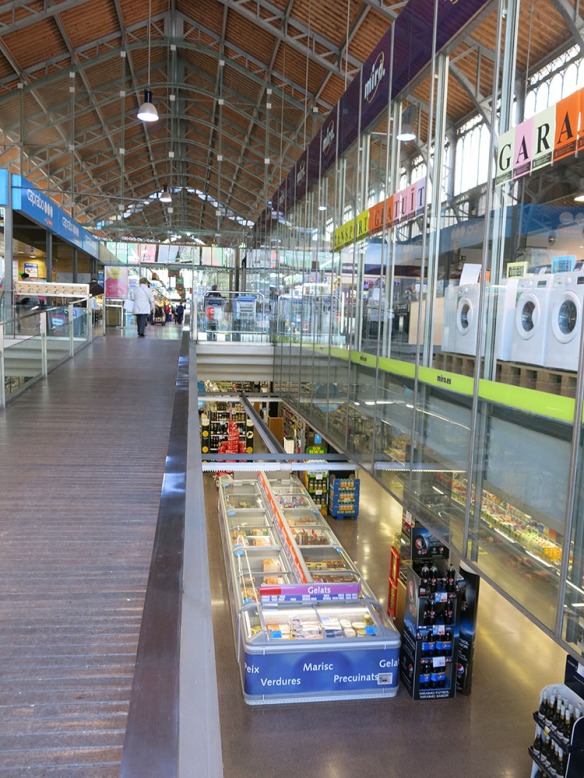
openings to the lower level reveal an entire supermarket of bottled and packaged foods, paper goods, household products, and even (above) washers and dryers. When you read about the current market organization, it turns out that they periodically survey their customer base and then shift directions accordingly so as to keep the market inventories current and attractive. What a concept for city living !
Next time, a tour of some of the work of Antoni Gaudi, including Sagrada Familia.

Mark, Great tour.
Ed
What an exciting city to visit.
We had visited Barcelona once before and enjoyed it so much we decided it would be worth a second trip – and it was.
I am glad! Sometimes second visits are disappointing. I have heard from others who have visited the city that it is a vibrant and unforgetable place.